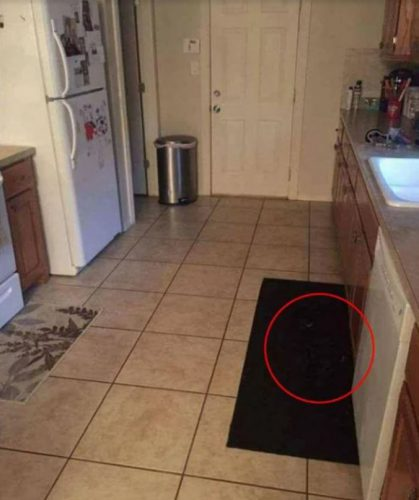At first glance, this photo looks like a typical kitchen scene—a refrigerator, a stove, a trash can, and a few floor mats. Everything appears to be in order. But there’s something hiding in plain sight. A dog is in the picture, but so far, only the owner can spot him.
Sounds impossible, right? Think again. This viral photo has left people staring for minutes, scratching their heads in disbelief. Can you find the hidden pooch? Let’s dive into the fascinating illusion at play and break down why it’s so hard to see what’s right in front of us.

The Power of Camouflage: Why We Miss What’s Right There
Camouflage isn’t just a trick used by animals in the wild—it can happen in everyday life too. The reason this photo is so challenging isn’t because the dog is hidden under something. He’s lying right in the open but blending perfectly with his surroundings.
The secret to this illusion? Color coordination. The dog’s fur almost perfectly matches an element in the kitchen, creating a seamless disguise. Your brain naturally scans the image, focusing on bigger objects and high-contrast details, but it overlooks what doesn’t immediately stand out.
This isn’t just a fun challenge—it’s a psychological test. Your mind is trained to look for patterns and familiar shapes. When something blends too well, your brain categorizes it as part of the background rather than a separate object.
At First Glance, Nothing Seems Out of Place
When you first look at the image, you probably see the kitchen and quickly assume you’ve taken in all the important details. There’s nothing obvious that looks like a dog, and that’s where the trick lies.
But take a second look. If you’ve been staring at the photo and still can’t find the dog, don’t worry—you’re not alone. Even the most observant people struggle with this one.
Hints to Help You Find the Hidden Dog
Need some help? Here are a few hints to guide you toward discovering the hidden pup:
🔹 It’s not on the tile floor. Many assume the dog is blending into the floor, but that’s not the case.
🔹 Look for reflections. A subtle clue appears in a reflection in the dishwasher door.
🔹 Focus on dark areas. The dog’s fur is blending with something dark-colored.
The Big Reveal: Where Is the Dog?
Still searching? Let’s unravel the mystery.
The dog is a black Labrador Retriever, curled up on a black floor mat right in front of the dishwasher. His fur matches the mat so perfectly that he’s nearly invisible!

Even when you know where to look, it still takes a moment for your brain to register the shape of the dog. His relaxed posture and the shadows further add to the illusion.
Why Do Most People Miss the Dog?
You might be wondering—why is it so hard to see something that’s right there?
Here’s what’s happening in your brain:
✔ Your mind groups objects by color and contrast. Since the dog and mat are the same shade, your brain registers them as one object.
✔ You expect a dog to stand out. When looking for an animal, we unconsciously look for familiar features—eyes, tails, or movement. Because the dog is lying still, it doesn’t trigger those recognition patterns.
✔ Your focus is on the wrong details. Your eyes naturally go to appliances and furniture, not the floor mats.
This is the same principle that allows wild animals to hide in plain sight. Camouflage works because our brains are wired to prioritize high-contrast details.
The Joy of Optical Illusions: Why We Love Puzzles Like This
People love visual challenges like this because they test our perception and observation skills. There’s something deeply satisfying about finding the hidden object—it’s like solving a mini-mystery.
These puzzles also help sharpen your attention to detail, which is useful in everyday life. The more you practice spotting hidden objects, the better you become at noticing small details in your surroundings.
Want to Improve Your Observation Skills? Try These Tips!
If you struggled to find the dog, don’t worry—you can train your brain to be better at spotting hidden details. Here’s how:
🔹 Slow down. Instead of scanning an image quickly, take your time to examine every part carefully.
🔹 Change your perspective. Look at objects from different angles or distances to see new details.
🔹 Focus on shadows and reflections. Subtle clues often appear in unexpected places.
🔹 Practice with more visual puzzles. The more you do, the sharper your eyes become!
The Takeaway: Things Aren’t Always as They Seem
This hidden dog challenge is a perfect example of how easily our eyes can deceive us. It reminds us that sometimes, the most obvious things are the hardest to see—until we shift our perspective.
So, did you find the dog before the reveal, or did it take a few hints? Either way, you now know that a simple change in focus can completely transform what you see.
Next time you’re looking at a puzzling image, take a second look—you never know what you might have missed the first time!